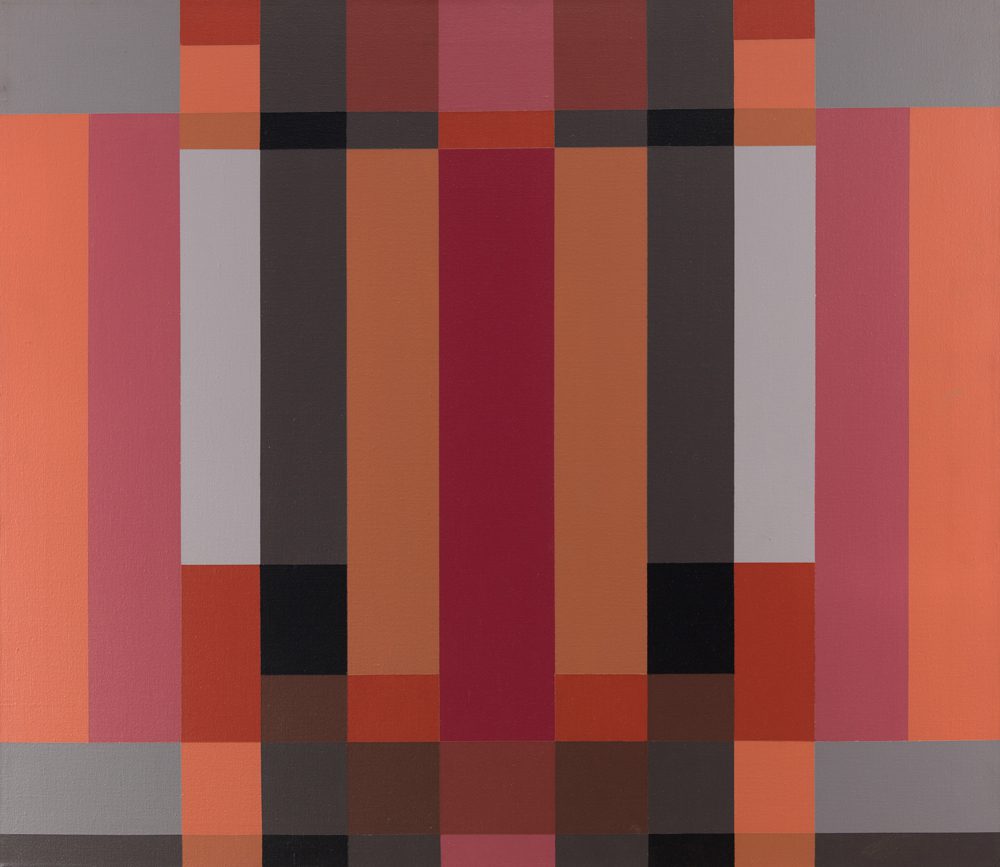Off the Wall: Fanny Sanín
In a new “Off the Wall” feature, Katie Pfohl, Curator of Modern and Contemporary Art at the New Orleans Museum of Art, discovers a painting by Colombia-born artist Fanny Sanín that points to the museum’s history of collecting Latin American art.

Fanny Sanín, Number 4, 1978. Acrylic on canvas. Courtesy the artist and the New Orleans Museum of Art.
Who: Katie Pfohl, Curator of Modern and Contemporary Art
Where: New Orleans Museum of Art
What: Fanny Sanín, Number 4, 1978. Acrylic on canvas.
When: About a month ago, I happened on a painting buried in NOMA’s art storage that has not been on view in decades. From beneath layers of cardboard and plastic emerged an impossibly precise and perfectly preserved abstract painting in pinks, oranges, and greys. Its stark geometry was utterly at odds with the surrounding stacks of art and storage boxes, and its artist—Fanny Sanín—was unknown, at least to me.
Two weeks later, I found myself sitting across from Fanny Sanín in her New York studio, learning about the life that lead her from a childhood in Bogotá, Colombia, to several years in Mexico City and London, and finally all the way to Manhattan. Now in her late 70s, Sanín is one of Latin America’s most celebrated female painters, and continues to participate in major exhibitions of Latin American art throughout Central America, Europe, and the United States. Although Sanín visited New Orleans only once, she showed me a group of photographs of her arm-in-arm with the many Latin American artists who flowed through the city during the 1960s, ’70s, and ’80s, including Mexican photographer Manuel Carrillo and Cuban painter and installation artist Luis Cruz Azaceta, who still calls the city his home.
Finding Sanín’s painting was, for me, the first step in uncovering a substantial—if little known—history of Modern Latin American art at NOMA. When the Polish sculptor Rela Banks gifted Number 4 to the museum in 1986, Sanín’s work joined a group of vanguard Op and Kinetic artworks from Latin America already in the collection, from the moveable parts of Jesús Rafael Soto’s paintings to Julio Le Parc’s optical illusions. NOMA collected these works during a frenzy of artistic and economic interest in the region that, in the early 1970s, inspired a group of influential museum patrons and donors to begin seriously collecting Modern Latin American art. These little known and rarely exhibited works stand as a vital legacy of the way NOMA has imagined and understood its relationship to the broader art of the Americas.
Why: Next spring, NOMA will put Sanín’s painting on view as part of a small focus exhibition of Modern Latin American artworks from the museum’s collection. Sanín’s paintings, like many of the other works in this show, propose abstraction as a vital form of cultural exchange. Sanín describes endlessly drawing maps of the differently colored nations she saw in geography class as a child, and she views her contemporary investigations of color and form to arise from a similar “process of searching.” Characterizing herself as “the result of a confrontation between cultures,” Sanín constantly explores new juxtapositions of color and form in her art. Never painting the same combination of color or form twice, her paintings are part of an ever-evolving inquiry into how we might create harmony from disunity and connection out of conflict. “Every painting I begin is a new problem,” she says, “and [my work] helps me come to terms with the problem.”



